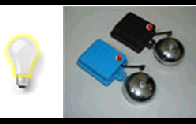Simple electric circuits
The components in any electric circuit are basically the same;
| 
|
aaaa |
Power supplyA battery or a power point in the wall (wall socket). This is the source of electrical potential energy that will push electric charges around a circuit, i.e. the power supply provides the energy to charges. |

|
|
Conducting leads Metal wires that conduct electric current to allow the electrical energy to travel through the conductors to the load. These leads are very good conductors and only a very small amount of electrical energy is required to move charges through them. Usually made of copper metal. |

|
|
A Load (Resistance)This is the electrical device where the electrical energy is converted into another form of energy, e.g. lightbulb converts electrical energy into light and heat, an electric bell converts the electrical energy into sound and heat. The load is a resistance to the current and causes the moving charges in the electricity to lose some of their energy as they pass through the device. The electrical energy is transformed. The more efficient the appliance, the more electrical energy does its primary job e.g. the more light a light bulb produces and the less heat it produces. |

|
|
A switch A switch opens and closes the circuit, i.e. breaks the conductive path when switched OFF (open) and makes an electric circuit when switched ON (closed). |
